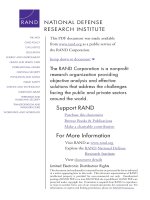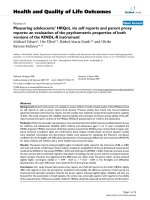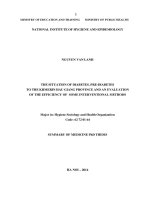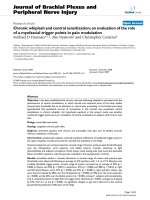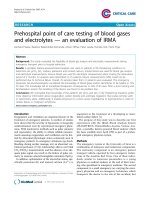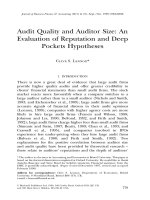An evaluation of enteral nutrition practices and nutritional provision in children during the entire length of stay in critical care
Bạn đang xem bản rút gọn của tài liệu. Xem và tải ngay bản đầy đủ của tài liệu tại đây (400.54 KB, 9 trang )
Mara et al. BMC Pediatrics 2014, 14:186
/>
RESEARCH ARTICLE
Open Access
An evaluation of enteral nutrition practices and
nutritional provision in children during the entire
length of stay in critical care
Jackie Mara1,2, Emma Gentles1,2*, Hani A Alfheeaid3, Krystalia Diamantidi3, Neil Spenceley1,3, Mark Davidson1,3,
David Young4 and Konstantinos Gerasimidis3
Abstract
Background: Provision of optimal nutrition in children in critical care is often challenging. This study evaluated
exclusive enteral nutrition (EN) provision practices and explored predictors of energy intake and delay of EN
advancement in critically ill children.
Methods: Data on intake and EN practices were collected on a daily basis and compared against predefined
targets and dietary reference values in a paediatric intensive care unit. Factors associated with intake and
advancement of EN were explored.
Results: Data were collected from 130 patients and 887 nutritional support days (NSDs). Delay to initiate EN was
longer in patients from both the General Surgical and congenital heart defect (CHD) Surgical groups [Median (IQR);
CHD Surgical group: 20.3 (16.4) vs General Surgical group: 11.4 (53.5) vs Medical group: 6.5 (10.9) hours; p ≤ 0.001].
Daily fasting time per patient was significantly longer in patients from the General Surgical and CHD Surgical
groups than those from the Medical group [% of 24 h, Median (IQR); CHD Surgical group: 24.0 (29.2) vs General
Surgical group: 41.7 (66.7) vs Medical group: 9.4 (21.9); p ≤ 0.001]. A lower proportion of fluids was delivered as EN
per patient (45% vs 73%) or per NSD (56% vs 73%) in those from the CHD Surgical group compared with those
with medical conditions. Protein and energy requirements were achieved in 38% and 33% of the NSDs. In a
substantial proportion of NSDs, minimum micronutrient recommendations were not met particularly in those
patients from the CHD Surgical group. A higher delivery of fluid requirements (p < 0.05) and a greater proportion
of these delivered as EN (p < 0.001) were associated with median energy intake during stay and delay of EN
advancement. Fasting (31%), fluid restriction (39%) for clinical reasons, procedures requiring feed cessation and
establishing EN (22%) were the most common reasons why target energy requirements were not met.
Conclusions: Provision of optimal EN support remains challenging and varies during hospitalisation and among
patients. Delivery of EN should be prioritized over other “non-nutritional” fluids whenever this is possible.
Keywords: Paediatric intensive care unit, Critical care, Enteral nutrition, Nutrition support
* Correspondence:
1
Paediatric Intensive Care Unit, Royal Hospital for Sick Children, NHS Greater
Glasgow and Clyde, Glasgow G3 8SJ, UK
2
Department of Dietetics and Nutrition, Royal Hospital for Sick Children, NHS
Greater Glasgow and Clyde, Glasgow G3 8SJ, UK
Full list of author information is available at the end of the article
© 2014 Mara et al.; licensee BioMed Central Ltd. This is an Open Access article distributed under the terms of the Creative
Commons Attribution License ( which permits unrestricted use, distribution, and
reproduction in any medium, provided the original work is properly credited. The Creative Commons Public Domain
Dedication waiver ( applies to the data made available in this article,
unless otherwise stated.
Mara et al. BMC Pediatrics 2014, 14:186
/>
Background
A substantial number of children in critical care are malnourished on admission and a proportion of them will
deteriorate due to the metabolic response to injury, surgery or inflammation [1,2]. Although nutritional support
is unlikely to reverse the course of illness, optimal nutritional support can minimize nutrient deficits and delay
establishment of malnutrition, thereby potentially improving the clinical outcome of the patient [3].
Thus, provision of optimal nutrition is central for the
health and disease prognosis of the critically ill child and
should be an integral part of any service aiming to provide optimal care. However this is not always easy to
achieve as the clinical team frequently encounters a
number of barriers to the estimation and delivery of nutritional support in the paediatric intensive care unit
(PICU) [4]. These include the estimation rather than
measurement of nutritional needs of the individual child,
under-prescription and inadequate delivery of nutrients
owing to strict fluid volume monitoring, interruptions or
cessation of nutritional support due to gastrointestinal
intolerance or mechanical problems, but also lack of nutritional awareness and routine assessment of patients
[4]. Thus, several paediatric intensive care units have reported their experience of improving the delivery of nutritional support and its impact on clinical outcomes by
implementation of nutritional management protocols
and guidelines [5-7].
Despite the ongoing debate on the impact of early nutritional support on clinical outcomes, such as reduction of
mortality, invasive ventilation and length of hospital stay
[8-10], in current practice every effort is given to initiate
early feeding and to improve the delivery of nutritional requirements using enteral nutrition (EN), limiting whenever possible use of the parenteral route. The effectiveness
of the nutritional adequacy of exclusive EN remains unclear and may vary according to the presence or not, of
multidisciplinary management and dietetic support.
Although there is substantial evidence to describe nutritional practices and provision in children admitted to
PICU [11,12] there are limited data to explore such aspects prospectively over the entire duration of hospital stay
and to study predictors associated with initiation, advancement and establishment of nutritional support [11,13].
Identifying modifiable barriers of nutritional provision and
windows for improvement will allow the clinical team to
intervene timely and adopt the optimal management plan
which will have the maximum possible benefit to the nutritional support and potentially clinical outcome of the sick
child in critical care.
We studied EN support practices and energy/nutrient
provision during the entire length of stay in a PICU and
explored factors associated with energy intake and successful advancement of EN.
Page 2 of 9
Methods
This study took place in a 22 bed mixed speciality PICU at
the Royal Hospital for Sick Children, Glasgow, United
Kingdom. Two cohorts of participants were included; one
between 1st January to 30th March 2009 and a second one
in the same period a year later. All patients with a PICU
length of stay of more than 48 hours and who were fed exclusively with EN were included. Children who received
partial or total parental nutrition support or oral diet during
admission were excluded in order to minimise heterogeneity in our nutritional support modalities as well as to explore whether using exclusive EN would allow delivery of
adequate energy/nutrient requirements. At the time of this
study there were two PICU specialist dietitians, a prescription pharmacist, and a senior critical care nutrition specialist nurse allocated to the unit. Patients were referred to
dietitians either on clinician’s request or according to local
clinical management pathways.
Information on patients’ disease characteristics were recorded from electronic records. Clinical conditions were
classified into three diagnostic groups: Medical (those admitted for non-surgical reasons), Congenital Heart Disease
(CHD) Surgical (those admitted after corrective heart surgery) and General Surgical (those admitted after undergoing any surgery other than corrective heart surgery). EN
support practices and nutritional intake were collected on a
daily basis from the unit Computerised Information System
(CIS, Metavision, iMDsoft®, Woking, United Kingdom).
These included: route of EN administration, time elapsed
from PICU admission to initiation of EN, daily fasting time,
enteral feed composition and total daily intravenous fluid
and EN volume administered. Data were recorded from the
time of PICU admission and were collected prospectively
for each complete 24 hour period of admission (nutritional
support day-NSD) and until discharge. Incomplete data
from the last day of PICU stay were excluded. During the
first period we also collected data on barriers of achieving
minimal energy requirements. This was not possible due to
logistical reasons in the second period.
In the absence of continuous monitoring of energy expenditure with indirect calorimetry, the assumption was
made that patients’ energy requirements were equal to
those of the basal metabolic rate (BMR) for healthy children
using the Schofield equations [14], with no correction for
stress factors [15]. This is common practice in UK and
other hospitals around the world. Fluid requirements were
calculated based on body weight [16]. Patients’ daily intake
of protein was expressed as a percentage of Reference Nutrient Intake (%RNI) while the intake of micronutrients was
classified as above or below the Lower Reference Nutrient
Intake (LRNI) [17]. Data on EN support practices and nutritional provision were presented in two ways: a) median
intake per patient during the entire PICU stay and b) median intake per NSD.
Mara et al. BMC Pediatrics 2014, 14:186
/>
Weight measurements were converted to z-score based
on the UK 1990 reference data corrected for gestational
age [18] and underweight was defined as a weight z-score
equal or below −2 SD.
Statistical analysis
Continuous variables were expressed as medians with
inter-quartile ranges and analysed with non-parametric
statistics (Kruskal-Wallis, Mann–Whitney tests) for differences between groups. Categorical data were presented
with counts and percentages and differences between
groups were explored with Chi-squared test or Fisher’s
exact test.
Factors predicting median energy intake (expressed as%
of BMR) during the duration of stay were explored with
univariate and multivariate (predictors with p < 0.1 were
entered in the model) stepwise linear regression analysis.
Predictors set a priori and included: age, prematurity,
weight z-score, diagnostic group, duration of stay in PICU,
time elapsed from admission to initiate EN, median daily
fasting time (%) during hospitalization, percent of fluid requirements delivered, fluid requirements delivered as EN
(%) and PIM2 (Paediatric Index of Mortality) score as
prognostic index of mortality which is computed using
clinical information collected at the time of admission to
PICU [19].
Similarly, delay to advance EN (i.e. number of days
elapsed between admission to provision of energy requirements equal to BMR) was explored with univariate
survival analysis on each predictor using Cox regression
analysis for quantitative variables and Log-rank test for
categorical variables. Variables which were significant at
the 5% level univariately, were used in a stepwise multivariate Cox regression model to determine which were
independently predictive of the time to achieve full nutritional requirements.
Statistical analysis was performed with MINITAB version 16 (Minitab Ltd) and SPSS version 21 at a 5% significance level.
Ethics approval
The study was registered with the local Clinical Effectiveness Department as a study auditing current clinical
practice.
Results
Patients’ characteristics
In total 130 patients were eligible and included. Twenty
eight (18%) others who received parenteral nutrition were
excluded. Children in the CHD Surgical and Medical
groups were significantly younger than those from the
General Surgical group (Table 1). Median weight z-score
was significantly lower in patients with CHD compared
with the General Surgical and Medical groups, and a third
Page 3 of 9
of this group were underweight as compared with approximately 15% and 18% of patients admitted with medical
conditions and for general surgical reasons respectively
(Table 1). Those in the CHD Surgical group had a significantly higher median PIM2 score than those from the General Surgical group [PIM2: Median (IQR); CHD Surgical
group: 2.3 (3.1) vs General Surgical group: 0.5 (4.2); p =
0.027] (Table 1). There was a trend towards the CHD Surgical group having a higher PIM2 score than the Medical
group (p = 0.067) and similarly for the latter compared with
the General Surgical group (p = 0.062) (Table 1). Three children died during the study period.
Enteral nutrition practices
The majority of the patients were fed via a nasogastric
tube. Five patients received EN via a nasojejunal tube
due to increased (two consecutive 4-hourly measured
gastric residual volumes > 5 ml/kg) gastric residual volumes (Table 2). High energy and elemental composition
feeds were used in 14% and 9.5% of the NSDs respectively. Ninety nine (76%) patients received EN support
within 24 hours of admission to PICU. Three patients
did not receive any form of nutritional support for the
entire duration of stay in the PICU (range of length of
hospital stay 3 to 6 days).
A significantly lower proportion of patients from the
CHD and General Surgical groups started EN support
within 24 hours of admission than patients admitted with
medical conditions [CHD Surgical group: 60% vs General
Surgical group: 55% vs Medical group: 90%; p ≤ 0.001]
(Table 2). Delay to initiate EN was significantly longer in
patients from both the General Surgical and CHD Surgical
groups compared to the Medical group [Median (IQR);
CHD Surgical group: 20.3 (16.4) vs General Surgical
group: 11.4 (53.5) vs Medical group: 6.5 (10.9) hours; p ≤
0.001] (Table 2). Similarly the median daily fasting time
per patient (not including the time to initiate EN) was significantly longer in patients from the General Surgical and
CHD Surgical groups than those from the Medical group
[% of 24 h, Median (IQR); CHD Surgical group: 24.0
(29.2) vs General Surgical group: 41.7 (66.7) vs Medical
group: 9.4 (21.9); p ≤ 0.001] (Table 2).
The volume of daily fluid delivered (% of requirements)
per patient or per NSD were significantly lower in CHD
Surgical patients and those admitted with medical conditions than those from the General Surgical group (Table 2).
However the percentage of total daily fluid delivered as
EN per NSD was lower in the General Surgical group
when compared to the General Medical group (Table 2).
A lower proportion of total fluid intake was delivered as
EN per patient or per NSD in those from the CHD Surgical group compared with those admitted with medical
conditions (Table 2).
Mara et al. BMC Pediatrics 2014, 14:186
/>
Page 4 of 9
Table 1 Demographics, anthropometry and disease characteristics of children admitted in a paediatric intensive care unit
Diagnostic group
CHD surgical
Medical
n = 48
n = 71
Median/N
IQR/%
Median/N
General surgical
n = 11
IQR/%
Median/N
NSDs
367
Corrected age (y)
0.3*
0.9
0.3**
1.8
4.9
11.3
37
77%
44
62%
3
27%
Male
32
67%
37
52%
6
54%
Female
16
33%
34
48%
5
45%
Premature
9
19%
11
15%
3
27%
Weight (kg)
4.9
4.3
6.2
7.8
22.8
23.3
Age <1 y
453
IQR/%
67
Gender
Weight z-score (SD)
−1.5
1.4
−0.3
1.9
−0.8
2.0
Weight z-score ≤ −2
15
31%
11
15%
2
18%
PIM2
2.3*
3.1
1.2
3.9
0.5
4.2
Ventilation time (h)
93.5
115.5
106.0
100.0
72.0
197.0
***
PICU LOS (d)
5.8
5.7
5.7
4.6
5.7
5.3
Total LOS (d)
18.0***
25.8
11.0
12.0
12.0
25.0
1
2.1%
2
2.8%
0
0%
Deceased
*
CHD Surgical significantly different from General Surgical; **Medical different from General Surgical; ***CHD Surgical significantly different from Medical; NSDs:
Nutritional Support Days; PIM2: Paediatric Index of Mortality score significantly; PICU LOS: Length of stay in paediatric intensive care unit (PICU), Total LOS: Total
length of stay in hospital (i.e. ward and intensive care unit) per patient; IQR: Interquartile range.
Table 2 Enteral nutrition practices and nutritional intake in children admitted in a paediatric intensive care unit by
diagnostic group
Diagnostic group
CHD surgical
Medical group
General surgical
n = 48
n = 71
n = 11
N (patients)
Time to start EN (h)
EN start <24 h
Nasojejunal feeding (d)
Median/N
IQR/%
Median/N
IQR/%
Median/N
20.3*
16.4
6.5***
10.9
11.4
IQR/%
53.5
29*
60%
64***
90%
6
55%
2
4.2%
3
4.2%
0
0%
% Daily fasting
24.0*
29.2
9.4***
21.9
41.7
66.7
% Fluid requirements
65.3**
15.2
64.6***
24.1
86.8
25.4
% Total fluid as EN
44.8*
34.8
73.3
25.4
31.9
80.7
Energy (% BMR)
53.2*
47.8
87.6
42.2
42.8
119.7
Protein (% RNI)
34.7*
57.7
56.2
60.8
54.6
129.1
Median/N
IQR/%
Median/N
IQR/%
Median/N
N (NSDs)
Nasojejunal feeding (d)
N = 367
N = 453
N = 67
IQR/%
16
4.3%
21
4.6%
0
0%
% Daily fasting
14.6*,**
43.8
4.2***
33.3
29.2
95.8
% Fluid requirements
66.7**
23.1
66.7***
25.3
94.1
28.8
*
56.2
72.7***
39.8
38.6
85.6
Energy (% BMR)
*
73.3
83.7
***
88.2
60.2
55.9
131.6
Protein (%RNI)
48.4*
78.7
60.0***
72.8
48.8
124.4
% Total fluid as EN
*
56.3
CHD Surgical significantly different from Medical; **CHD Surgical significantly different from general Surgical; ***Medical different from general Surgical; % Daily
Fasting: Daily fasting hours expressed as percentage of 24 hours (excluding time to initiate feeding on admission); % Fluid Requirements: Percentage of daily fluid
requirements delivered; % Total Fluid as EN: Percentage of total fluid volume delivered as enteral nutrition; BMR: Basal Metabolic Rate; RNI: Recommended
Nutrient Intake; IQR: Interquartile range.
Mara et al. BMC Pediatrics 2014, 14:186
/>
Page 5 of 9
Energy and nutrient intake in PICU
The median daily intakes of energy (%BMR) and protein (%
RNI) were significantly lower in the CHD Surgical patients
compared with the General Medical group (Table 2). Energy requirements equal to BMR and protein requirements
equal to RNI were not achieved in more than 62% and 67%
of the NSDs respectively with no significant differences between the diagnostic groups (Figure 1). Ninety two percent
of the patients received less than 100% of their BMR requirements at the first day of admission compared with
75% and 71% at the end of the second and third day respectively. Among the diagnostic groups, energy intake was
worse for the CHD Surgical group (Figure 2). Minimum
nutrient requirements (LRNI) were not achieved for a substantial number of NSD and for the large majority of
micronutrients studied (Figure 1). In a higher proportion of
NSD minimum micronutrient recommendations were
achieved in the Medical and General Surgical groups compared to the CHD Surgical (Figure 1) but this varied and a
particular pattern was not uniform across the individual
micronutrients studied (Figure 1).
Predictors of energy intake and delay of EN advancement
Median energy intakes per day of admission and diagnostic group are displayed in Figure 2. Independent predictors
of median daily energy intake (%BMR) and delay of EN
Zn
Se
Mg
Fe
Ca
Folic Acid
Vit C
Vit B12
Vit B3
Vit B2
Vit B1
Vit A
Protein
Energy
0
10
20
30
General Medical
40
50
CHD Surgical
60
70
80
90
General Surgical
Figure 1 Proportion (%) of nutritional support days where daily requirements for energy (BMR), protein (RNI) and micronutrient (LRNI)
were not achieved by diagnostic group. BMR: Basal metabolic rate; RNI: Recommended nutrient intake; LRNI: Lowest recommended nutrient
intake; CHD: congenital heart defects.
Mara et al. BMC Pediatrics 2014, 14:186
/>
Page 6 of 9
Figure 2 Box plots of energy intake during stay in a paediatric intensive care unit (truncated to 14 days) by diagnostic group.
The width of the box is proportional to the number of measurements at each day of hospital stay.
advancement were explored for the entire cohort of participants. A higher delivery of fluid requirements and a
greater proportion of these delivered as EN, were independently associated with median energy intake during
PICU stay and delay of EN advancement (Table 3). Similarly, child’s age was negatively associated with median energy intake in multivariate analysis (Table 3). These three
factors explained 85% of the variation in median daily energy intake.
Reasons of failing to achieve energy requirements
In the first period of the study, reasons for failing to
achieve energy requirements were collected on daily basis.
From the 477 NSDs, energy requirements equal to BMR
were not delivered in 338 (71%). This was due to fasting
(n = 104, 31%) and fluid restriction (n = 132, 39%) for clinical reasons, procedures being undertaken in the ward and
establishing enteral feeding (n = 74, 22%). For the remaining
27 (8%) NSDs this was due to other reasons (e.g. raised gastric residual volumes, abdominal distension).
Discussion
The results of this study highlight that under current
multidisciplinary management delivery of minimal
estimated requirements using exclusive EN was not
optimal with the majority of patients achieving energy
requirements lower than BMR and nutrient intakes
lower than the minimal dietary references. This was
particularly evident in the CHD Surgical group, where
a substantial proportion of patients were already
underweight on admission. The results of this study
are similar to previous literature in children in critical
care although a direct comparison is difficult due to
differences in methodological aspects among the studies. Taylor et al. showed a median delivery of 60% of
predefined targets during hospitalisation [20], de
Oliveira Inglesias et al. reported that prescription and delivery of energy were not adequate in > 50% of enteral
nutrition support days [12] and de Neef et al. found large
inter-individual variations in the energy and nutrient intake during the first 10 days of admission [11].
In this study we explored predictors associated with
nutritional delivery and speed of advancement of EN.
Although disease diagnosis was a strong predictor in the
univariate analysis this association was confounded with
other potential determinants. The amount of fluid administered and a larger fraction of this delivered as EN
were the strongest independent predictors.
Mara et al. BMC Pediatrics 2014, 14:186
/>
Page 7 of 9
Table 3 Predictors of median energy intake during stay and delay of initial exclusive enteral nutrition advancement in
a paediatric intensive care unit
Delay of EN advancement
Univariate
Hazard ratio
Median energy intake
p-value
Coefficient
p-value
[95% CI]
Age (y)
0.97 [0.90: 1.04]
0.410
-2.07
0.088
Prematurity
0.85 [0.63: 1.16]
0.311
-0.10
0.984
Weight z-score (SD)
0.96 [0.84: 1.11]
0.611
0.76
0.744
Medical vs CHD
1.74 [1.08: 2.79]
0.022
18.3
0.001
Surgical vs CHD
0.97 [0.39: 2.38]
0.945
-7.1
0.401
PICU LOS (d)
0.99 [0.97: 1.02]
0.739
Diagnosis
Delay to initiate EN (h)
1.16
0.021
-0.98
<0.001
% Daily fasting
0.98 [0.96: 0.99]
0.001
-1.17
<0.001
% Fluid requirements
1.01 [1.00: 1.02]
0.046
0.46
0.025
% Total fluid as EN
1.03 [1.02: 1.04]
<0.001
1.40
<0.001
PIM2
0.97 [0.93: 1.01]
0.163
-0.76
0.023
1.03 [1.02: 1.04]
<0.001
Multivariate
% Total fluid as EN
Age (d)
% Fluid requirements
1.02 [1.00: 1.03]
0.004
1.36
<0.001
-2.26
<0.001
0.73
<0.001
Delay of EN advancement: Days to achieve energy requirements equal of basal metabolic rate (BMR); Median energy intake: Median energy intake (%BMR) during
the entire length of stay in Paediatric Intensive Care Unit (PICU). Delay to initiate EN (h): Time elapsed from admission to PICU to initiation of enteral nutrition; %
Daily Fasting: Daily fasting hours expressed as percentage of 24 hours (excluding time to initiate feeding on admission); % Fluid Requirements: Percentage of daily
fluid requirements delivered; % Total Fluid as EN: Percentage of total fluid volume delivered as enteral nutrition; PIM2: Paediatric Index of Mortality score; PICU
LOS: Length of stay in PICU.
Previous studies have also highlighted fluid restriction,
fasting prior to clinical procedures and intolerance to
EN support as primary reasons of failing to achieve optimal nutritional support in critically ill paediatric patients
[11-13]. Indeed our findings are in agreement with those by
Rogers et al. in Australia, where restriction of fluid intake
was the main barrier to the delivery of adequate nutrition,
particularly in infants undergoing cardiac surgery [21].
The current findings are in accordance with this evidence
and suggest that fluid requirements should be optimised
whenever possible and this should be done via nutritionally
rich fluids in the form of EN or parenteral nutrition. This
may be particularly important in fluid restricted patients
where nutritional requirements are difficult to achieve. In
the current study, the children with CHD were largely malnourished on hospital admission and were more likely to
be sicker. In this nutritionally vulnerable group of children,
with increased energy and nutrient demands [22], use of
high energy feeds may be another option to consider improving nutritional intake until delivery of fluid and nutritional support becomes more liberal.
It has been previously shown that early initiation of feeding may improve nutritional delivery and implementation
of local management protocols may facilitate this process
[6]. Although it could be suggested that patients who cannot tolerate EN should be supplemented with PN this may
not be appropriate in all patients particularly those who can
only tolerate low volumes of fluids or in whom intravenous access for PN delivery is unavailable. However when
delay or failure to establish EN is not complicated by fluid
restriction, supplementation with PN should be initiated
promptly. The clinical efficacy of such nutritional support
modalities along with the routine use of high energy feeds
need to be explored in future prospective studies.
In contrast to previous studies which assessed energy and
nutrient intake on few selected or random days during
PICU stay [12,23] this study recorded nutritional support
practices over the patients’ entire length of stay in PICU
covering nutritional support data from 887 days. This offers
a more comprehensive insight into nutritional support practices and EN provision in patients in PICU and explores patterns associated with the overall intake and advancement of
EN support over the course of their admission.
Micronutrients are important for health and in critical
care requirements may be higher [24]. Intake of vitamins
and mineral was suboptimal and well below the minimal
requirements for a large proportion of NSDs. In the short
term this may have very little importance particularly in
Mara et al. BMC Pediatrics 2014, 14:186
/>
children with a good nutritional status prior to hospital
admission. However for those who were already malnourished and more difficult to feed, micronutrient supplementation or development and clinical evaluation of new
optimized nutritional feeds with better micronutrient profile for exclusive use in PICU may be needed and their impact on nutritional and clinical outcomes should be
explored in future studies.
The exclusion of patients on parenteral nutrition support may be seen as a limitation of the study. However a
secondary aim of this study was to explore whether we
were able to deliver optimal nutritional support through
the enteral route, sparing the use of parenteral nutrition.
By doing that we have highlighted patients in whom delivery of optimal EN support is challenging and more
targeted feeding protocols and use of PN should be used
whenever this is possible. The efficacy of these measures
should be explored in the future. We also hypothesised
that energy requirements equal those of BMR, instead of
measuring gaseous exchange with indirect calorimetry
[25] and previous studies have shown large discrepancies
between predicted and measured energy requirements.
However, even if such facilities were available, the results
of the current study suggest that it might have still been
challenging to achieve optimal nutritional requirements.
Conclusions
This study highlights the complexities and challenges of
the nutritional management of the critically ill child. It
shows that within current multidisciplinary practice, nutritional requirements of healthy children are rarely
achieved in paediatric critical care. However, every effort
should be made by the nutritional support team to optimise nutritional delivery using every possible resource
and when this is possible. Such efforts and better nutritional support practices may be facilitated by increasing
nutritional awareness and implementation of local management protocols in routine clinical practice [5-7].
Competing interests
The authors have no conflicts of interest to declare.
Authors’ contributions
EG, JM, KD, HA collected the data; EG, KG, DY carried out the data/statistical
analysis; EG, KG, JM drafted the manuscript; MD, NS, DY contributed to data
interpretation and revised the manuscript. All authors read and approved the
final manuscript.
Acknowledgements
We would like to thank the medical and nursing staff for their support with
this study and particularly Susan Miller & Isobel Macleod for the
development of the PICU bedside NJ insertion guidelines and their ongoing
support of optimal nutritional support within PICU.
Conference presentations: Part of this study was presented in the ESPEN
meeting 2012, Barcelona.
Author details
1
Paediatric Intensive Care Unit, Royal Hospital for Sick Children, NHS Greater
Glasgow and Clyde, Glasgow G3 8SJ, UK. 2Department of Dietetics and
Page 8 of 9
Nutrition, Royal Hospital for Sick Children, NHS Greater Glasgow and Clyde,
Glasgow G3 8SJ, UK. 3Human Nutrition, School of Medicine, College of
Medicine, Veterinary and Life Sciences, University of Glasgow, Glasgow G3
8SJ, UK. 4Department of Mathematics and Statistics, University of Strathclyde,
Glasgow G1 1XH, UK.
Received: 31 March 2014 Accepted: 17 July 2014
Published: 21 July 2014
References
1. Hulst J, Joosten K, Zimmermann L, Hop W, van BS, Buller H, Tibboel D,
van GJ: Malnutrition in critically ill children: from admission to 6 months
after discharge. ClinNutr 2004, 23:223–232.
2. Hulst JM, van Goudoever JB, Zimmermann LJ, Hop WC, Albers MJ, Tibboel D,
Joosten KF: The effect of cumulative energy and protein deficiency on
anthropometric parameters in a pediatric ICU population. ClinNutr 2004,
23:1381–1389.
3. Pollack MM, Ruttimann UE, Wiley JS: Nutritional depletions in critically ill
children: associations with physiologic instability and increased quantity
of care. JPEN JParenterEnteral Nutr 1985, 9:309–313.
4. Hulst JM, Joosten KF, Tibboel D, van Goudoever JB: Causes and
consequences of inadequate substrate supply to pediatric ICU patients.
CurrOpinClinNutrMetab Care 2006, 9:297–303.
5. Briassoulis GC, Zavras NJ, Hatzis MDTD: Effectiveness and safety of a
protocol for promotion of early intragastric feeding in critically ill
children. Pediatr Crit Care Med 2001, 2:113–121.
6. Meyer R, Harrison S, Sargent S, Ramnarayan P, Habibi P, Labadarios D: The
impact of enteral feeding protocols on nutritional support in critically ill
children. JHumNutrDiet 2009, 22:428–436.
7. Petrillo-Albarano T, Pettignano R, Asfaw M, Easley K: Use of a feeding
protocol to improve nutritional support through early, aggressive,
enteral nutrition in the pediatric intensive care unit. PediatrCrit Care Med
2006, 7:340–344.
8. Doig GS, Simpson F, Finfer S, Delaney A, Davies AR, Mitchell I, Dobb G:
Effect of evidence-based feeding guidelines on mortality of critically ill
adults: a cluster randomized controlled trial. JAMA 2008, 300:2731–2741.
9. Doig GS, Simpson F, Sweetman EA, Finfer SR, Cooper DJ, Heighes PT, Davies AR,
O'Leary M, Solano T, Peake S: Early parenteral nutrition in critically ill patients
with short-term relative contraindications to early enteral nutrition: a
randomized controlled trial. JAMA 2013, 309:2130–2138.
10. Mikhailov TA, Kuhn EM, Manzi J, Christensen M, Collins M, Brown A-M,
Dechert R, Scanlon MC, Wakeham MK, Goday PS: Early Enteral Nutrition Is
Associated With Lower Mortality in Critically Ill Children. JPEN J Parenter.
Enteral Nutr 2014, 38:459–466.
11. de NM, Geukers VG, Dral A, Lindeboom R, Sauerwein HP, Bos AP:
Nutritional goals, prescription and delivery in a pediatric intensive care
unit. ClinNutr 2008, 27:65–71.
12. de Oliveira Iglesias SB, Leite HP, SeM JF, de Carvalho WB: Enteral nutrition
in critically ill children: are prescription and delivery according to their
energy requirements? NutrClinPract 2007, 22:233–239.
13. Lambe C, Hubert P, Jouvet P, Cosnes J, Colomb V: A nutritional support
team in the pediatric intensive care unit: changes and factors impeding
appropriate nutrition. ClinNutr 2007, 26:355–363.
14. Schofield WN: Predicting basal metabolic rate, new standards and review
of previous work. Hum Nutr ClinNutr 1985, 39(Suppl 1):5–41.
15. Rousseau AF, Losser MR, Ichai C, Berger MM: ESPEN endorsed
recommendations: nutritional therapy in major burns. ClinNutr 2013,
32:497–502.
16. Holliday MA, Segar WE: The maintenance need for water in parenteral
fluid therapy. Pediatrics 1957, 19:823–832.
17. Health DO: Dietary Reference Values for Food Energy and Nutrient for
the United Kingdom. Report on Health and Social Subjects No. 41.
In; 1991.
18. Cole TJ: Growth charts for both cross-sectional and longitudinal data.
StatMed 1994, 13:2477–2492.
19. Slater A, Shann F, Pearson G, Grp PS: PIM2: a revised version of the
Paediatric Index of Mortality. Intensive Care Med 2003, 29:278–285.
20. Taylor RM, Preedy VR, Baker AJ, Grimble G: Nutritional support in critically
ill children. Clin Nutr 2003, 22:365–369.
21. Rogers EJ, Gilbertson HR, Heine RG, Henning R: Barriers to adequate
nutrition in critically ill children. Nutrition 2003, 19:865–868.
Mara et al. BMC Pediatrics 2014, 14:186
/>
Page 9 of 9
22. Mitchell IM, Logan RW, Pollock JC, Jamieson MP: Nutritional status of
children with congenital heart disease. Br Heart J 1995, 73:277–283.
23. Woien H, Bjork IT: Nutrition of the critically ill patient and effects of
implementing a nutritional support algorithm in ICU. J ClinNurs 2006,
15:168–177.
24. Lima LF, Leite HP, Taddei JA: Low blood thiamine concentrations in
children upon admission to the intensive care unit: risk factors and
prognostic significance. Am J Clin Nutr 2011, 93:57–61.
25. Vazquez Martinez JL, Martinez-Romillo PD, Diez Sebastian J, Ruza Tarrio F:
Predicted versus measured energy expenditure by continuous, online
indirect calorimetry in ventilated, critically ill children during the early
postinjury period. Pediatr Crit Care Med 2004, 5:19–27.
doi:10.1186/1471-2431-14-186
Cite this article as: Mara et al.: An evaluation of enteral nutrition
practices and nutritional provision in children during the entire length
of stay in critical care. BMC Pediatrics 2014 14:186.
Submit your next manuscript to BioMed Central
and take full advantage of:
• Convenient online submission
• Thorough peer review
• No space constraints or color figure charges
• Immediate publication on acceptance
• Inclusion in PubMed, CAS, Scopus and Google Scholar
• Research which is freely available for redistribution
Submit your manuscript at
www.biomedcentral.com/submit
